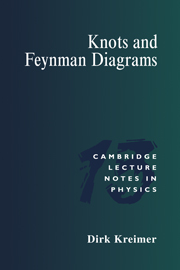Book contents
- Frontmatter
- Contents
- Acknowledgements
- 1 Introduction
- 2 Perturbative quantum field theory
- 3 The Hopf algebra structure of renormalization
- 4 Rationality: no knots, no transcendentals
- 5 The simplest link diagrams
- 6 Necessary topics from knot theory
- 7 Knots to numbers: (2, 2n – 3) torus knots and ζ(2n – 3)
- 8 One-loop words
- 9 Euler–Zagier sums
- 10 Knots and transcendentals
- 11 The four-term relation
- 12 Hopf algebras, non-commutative geometry, and what else?
- References
- Index
7 - Knots to numbers: (2, 2n – 3) torus knots and ζ(2n – 3)
Published online by Cambridge University Press: 04 August 2010
- Frontmatter
- Contents
- Acknowledgements
- 1 Introduction
- 2 Perturbative quantum field theory
- 3 The Hopf algebra structure of renormalization
- 4 Rationality: no knots, no transcendentals
- 5 The simplest link diagrams
- 6 Necessary topics from knot theory
- 7 Knots to numbers: (2, 2n – 3) torus knots and ζ(2n – 3)
- 8 One-loop words
- 9 Euler–Zagier sums
- 10 Knots and transcendentals
- 11 The four-term relation
- 12 Hopf algebras, non-commutative geometry, and what else?
- References
- Index
Summary
In this chapter we want to demonstrate the appearance of knots extracted from the topology of Feynman graphs. Following the intuitive approach of Chapter 5 we will investigate certain Feynman graphs which will deliver the (2, q) torus knots. We will see that the appearance of this knot is accompanied by the appearance of the transcendental ζ(q) in the corresponding counterterms.
In Section 7.1 we will demonstrate the appearance of ζ(3) by calculating the first non-trivial topology. Afterwards, we investigate the corresponding topology in some detail.
ζ(3) from a counterterm
We are interested in the simplest Feynman graph which has a non-trivial topology. At two loops, if we disregard external momenta, there is only one topology, which is a ladder topology with one rung. The first possibility of a non-ladder topology appears at three loops.
Obviously, this is the topology given in Fig. 7.1. The simplest theory to realize this as a graph without subdivergences is as a contribution to the four-point vertex in ϕ4-theory, which at nullified external momenta can also be read as a log-divergent three-loop vacuum bubble in massive ϕ3 theory in four dimensions. As far as its UV-divergences are concerned, this makes no difference. As an overall log-divergent function the divergence is independent of parameters like masses and external momenta.
Thus, let us nullify all masses and momenta with the implicit understanding that we will keep one mass in one propagator.
- Type
- Chapter
- Information
- Knots and Feynman Diagrams , pp. 130 - 142Publisher: Cambridge University PressPrint publication year: 2000



